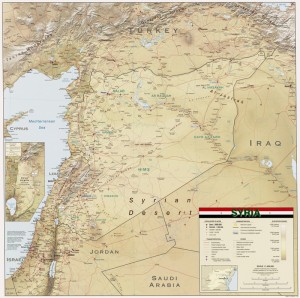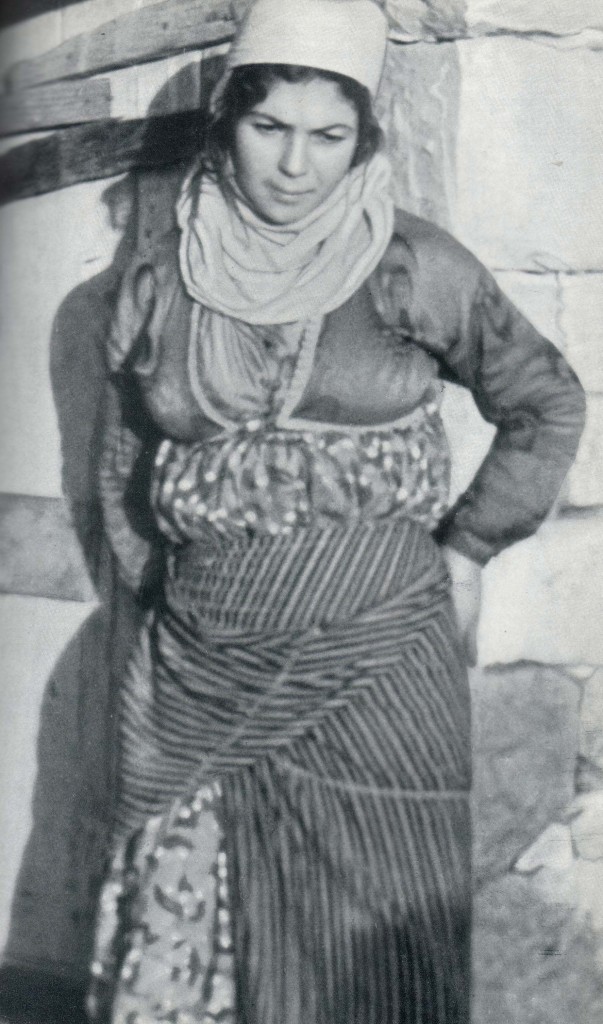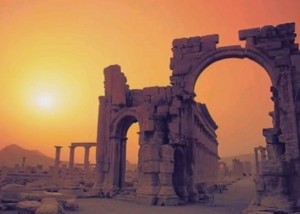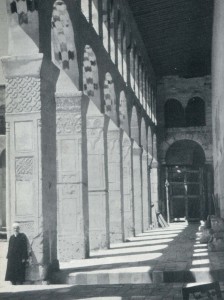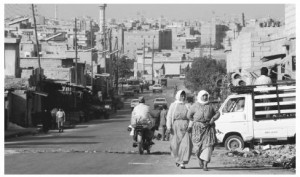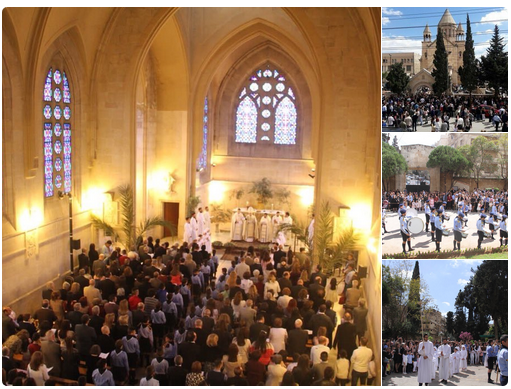
 More than one time the CNN coverage of crises brought back memories of countries in which I traveled during the seventies, but would not like to go today. Currently it is news from Syria, which triggered this more personal article. Some of the information came from a old travel guide and a book of Julian Huxley (UNESCO Official) From an Antique Land, London 1954. The pictures I own are mainly postcards, since I have lost most of my photographs.
More than one time the CNN coverage of crises brought back memories of countries in which I traveled during the seventies, but would not like to go today. Currently it is news from Syria, which triggered this more personal article. Some of the information came from a old travel guide and a book of Julian Huxley (UNESCO Official) From an Antique Land, London 1954. The pictures I own are mainly postcards, since I have lost most of my photographs.
In 1971 I travelled with two friends extensively in the Middle East, in particular Lebanon and Syria. Beirut was still the Paris of the East then, before it become rubble in a religious war. Due to a mishap – a car accident on an outbound highway – we were forced to stay much longer in Damascus than we planned. We experienced more of the Kafkaesque judicial system of Baath regime than we really cared for. In March 1971 the Baath Party by a national referendum just had voted for Assad. Syria’s Hafez el Assad, his son, is now in power since June 2000 He is one of the Middle East’s most ruthless, autocratic, minority rulers in one of the world’s most closed societies. Government. Syria adopted its current constitution in 1973. The unicameral legislative branch is composed of the People’s Council, or Majlis al shaab, whose 195 members are elected for four-year terms. This body proposes laws, discusses cabinet programs, and approves the national budget. The president, who serves as the head of state and is required by the constitution to be a Muslim, is elected every seven years by popular vote. The president appoints a vice president, a prime minister who serves as head of government, a cabinet, and deputy prime ministers. The president has wide-reaching powers, including serving on the supreme court. Despite the distribution of political power, in practice, the military government has the ability to overrule all decisions.
Syria. Well, going back to 1971, it wasn’t open then, but despite of this we met lots of Arabic hospitality. We drove with a VW convertible, which not once let us down in a 4000 mi journey. We crossed through the whole Balkan and Turkey and went over a sleepy Syrian / Turkish border, continuing to Antioch to visit the famous Church of St. Paul. I reconstructed the routes, there were the roads taken by the pilgrims in medieval ages. At the border we drank Raki (Arak) with the custom guard. Alcohol consumption is rare, as it is forbidden by the Islamic religion, but beer and wine was available, as is arak, an aniseed drink that was more popular in other Middle Eastern countries. We went to Aleppo, visited the citadel at Qalaat Jaabar and Palmyra once on a flourishing trade route. We detoured to Beirut and from there to Damascus, the oldest continuously occupied capital in the world, located at the base of Mt. Kassion, which separates it from Lebanon.
Arrival in Damascus. When we finally arrived in Damascus, we went in something which looked like a hotel lobby (we couldn’t read the Arabic sign), but it was a long-distance-cab agency situated on a large roundabout . Except for the huge minaret it looked very much like in this recent picture below, with mountains visible in the background. I just have postcards left from this time, which is sad. A more detailed (large file) you find here.

The busy Liberation Square in Damascus. The city is one of the oldest inhabited places in the world, but now it is also a very modern city.
For us dropping in this long-distance-cab agency was very lucky, a real honey pot. Soon we would know the whole city. There were probably only few brave Caucasians at that time, 10o mi apart from a hot border with shootings.
The war. A limited war fought between Israeli military and forces of the Egyptian Republic, the USSR, Jordan, Syria and the Palestine Liberation Organization from 1967 to 1970 just had ended in a ceasefire and the Yom Kippur War, a joint surprise attack on Israel in October 1973 was in the make. I saw other Caucasians only one time in Damascus, blond fit men, looking very Russian to me.
Living in Damascus we stayed in a small hotel and made many acquaintances via the long-distance-cab drivers, who showed us around in a big American car (their cab). That came handy, because our car was confiscated. They introduced us to other friends, who introduced us to their friends and so we got invited every night after dinner. At five pm we would have dinner at our usual restaurant. Lots of very good prepared lamb. I still remember the food, the milk with honey, the terrific fat and sugary cookies, the people, the Syriac music, the surrounding mountains and the cool breeze in the evening. Between 11 and 4 it was hot. I mean hot – not humid hot – real hot. Damascus is in a valley surrounded by beautiful mountains. One time from the picnic area we looked down – stars above us, lights down there, cars the road up like a string of pearls.
Dealing with Kafka. My other friend the driver, was not that lucky. He went right from the police station – that would be another story – to prison. The prison not only looked like it was built during Roman time and never renovated – it was. Our embassy proved to be useless; we were to them just idiotic youngsters, making holiday in a country, tougher than the USSR. After weeks of negotiation we could bail him out, raising 800 USD . I still remember all those court rooms and police stations. Noisy and shabby, but cooler than outside, a pretty chaotic scene. We could only communicate in our school French but somehow we managed to deal with a dark system and still experienced some courtesy.
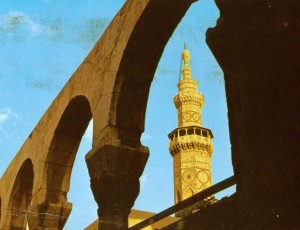 The people. Well that was then. No pictures except those in my mind. At that time 1971 I meet straightforward people in a very secular state. In the hotel in Damascus, we would discuss with Palestinian refugees. Later in my career, I would work for a long time with Israeli engineers from which I would learn their side of the story and was an equal pleasant experience. One of the best remarks I heard about the Middle East was, the objective truth simply is no valid operating paradigm in a conflict which has its roots in 2000 years of history.
The people. Well that was then. No pictures except those in my mind. At that time 1971 I meet straightforward people in a very secular state. In the hotel in Damascus, we would discuss with Palestinian refugees. Later in my career, I would work for a long time with Israeli engineers from which I would learn their side of the story and was an equal pleasant experience. One of the best remarks I heard about the Middle East was, the objective truth simply is no valid operating paradigm in a conflict which has its roots in 2000 years of history.
Syrian society was traditionally extremely stratified. People from different classes generally do not socialize with one another, and people in the lower classes often adopt a humble attitude and an acceptance of their position. Class lines tend to coincide with racial differences, as lighter-skinned people hold higher economic and political positions and most of the people in the lower-ranked professions are darker-skinned. The families of landholders and merchants traditionally occupied the highest position socially and politically. They usually lived in Damascus or Aleppo and managed their land from afar. Religious teachers known as ulama were also influential. The Baath government has created some shifts in that pattern. Some peasants are moving to the cities and joining the middle class; others now own land. However, there are still large numbers of indigent and landless peasants. Since the Baath takeover, the army officers who participated in the coup have succeeded the landowners as the new elite. There is also a growing middle class as a result of the spread of education. The wealthy and well educated have a fairly modern lifestyle with many of the trappings of Western life. Dress is another indicator of social class. Traditionally, it is a sign of wealth and status in a family for its women to dress in long robes with their faces veiled.
Lying at the east end of Suq al Hamidiyeh, it is a place of magnificent beauty. This site has been marked by sacred enclosures as far back as the second millennium BC. This cult center was first used as a temple (9th century BC) dedicated to the worship of Hadad, who is the Aramean deity representing sun and thunder. Later on, in the 1st century AD, it was taken by the Romans to make it larger Temple of God of the Gods, Jupiter.
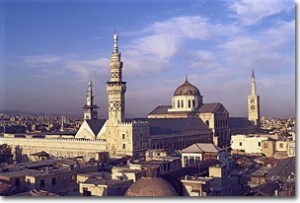 When the Roman capital moved from Rome to Constantinople in 330, Christianity began to spread in the empire and was soon considered the official religion. It was then that the Emperor Theodosius (ruled 193 – 211) abolished pagan worship and made it the cathedral of the city, thus it was dedicated to John the Baptist.
When the Roman capital moved from Rome to Constantinople in 330, Christianity began to spread in the empire and was soon considered the official religion. It was then that the Emperor Theodosius (ruled 193 – 211) abolished pagan worship and made it the cathedral of the city, thus it was dedicated to John the Baptist.
With the taking of Damascus by the Arabs in 636, Christians were generally allowed to continue to use their churches and Muslims were settled in new areas of the city. During the first 70 years, the Muslims had built a mud brick structure against the southern wall so that they could pray. Afterwards, Christians became few and Muslims were increasing, so it was changed into a mosque under the rule of the Caliph al-Walid (ruled 705 – 715). The renovation work was done by Architects from Constantinople, Egypt, and Damascus itself.
It now holds the Shrine of John the Baptist’s head, and there are many rumors to explain how it came to be here. One is that Herod sent it to Damascus so that the Romans could be sure of his execution; while another is that when the Arabs took over the church, John the Baptist’s blood bubbled and when the church was being demolished his head was found underneath it with skin and hair. The plan of the mosque is quite simple; there is a magnificent courtyard which is heavily decorated by mosaics. In the middle of the courtyard are the Dome of the hours, the ablutions fountain and the beautifully decorated Dome of the treasure. This mosque is one of the few mosques that has three minarets, Minaret of the Bride (9th and 12th centuries), Minaret of Qayetbey (15th century), and the Minaret of Issa (Jesus) (13th century).
Given its setting on flat ground, hemmed in by cluttered urban surrounds, the fortifications never presented the same forbidding front. This citadel stands at the northwest corner of the Old City. It is much smaller than that of Aleppo, and is the only citadel in Syria that is on the same level as the rest of the city.
In that citadel my friend imprisoned
The Roman cast rum or camp was here. Still, there’s no firm evidence it was used as military base in Roman times. Most of the construction is from the Ayyūbid and Mameluke periods but heavy use since then has not been kind to the fabric. The Sultan al Adel used this fortification to preserve Damascus (1207) against the Crusaders and Mongols in the 13th century. Then Damascus had become the key center of Arab resistance to the Crusader presence, a role built up particularly under the leadership of Saladin (1176 – 93). In 1260, however, it was destroyed by the first Mongol invasion. It was rebuilt by the Mameluke Sultan Baybars, who made sure that the original 16 towers and walls were rebuilt. However, it was to be heavily knocked down by the second Mongol invasion in 1400 by Timurlenk (Tamerlane). The Ottomans did not really pay much attention to it and it was only slightly repaired, though they used it as military base.
The religions. It is generally thought that the Alawites trace their origins to a sectarian splitting a Shiite cult of Islam. Their faith has retained many non-Islamic, early oriental beliefs. Some ‘ Alawite doctrines appear to derive from Phoenician paganism and Manichaeism. But by far the greatest affinity is with Christianity. ‘Alawite religious ceremonies involve bread and wine and have an own concept of holy trinity. Alawites celebrate many Christian festivals and honor many Christian saints, notable. John the Baptist and St. Mary Magdalene. Arabic equivalents Christian personal names as Gabriel, John, Matthew, Catherine, and Helen, are in common use.
The history.
Damascus became the capital of the Persian province of Syria after Cyrus the Great conquered the city in 538 B.C. Alexander the Great finished the Persian domination but … soon after (323 B.C.) he died. Damascus and Syria in general became the point of contention between the Seleucid and Ptolemaic rulers. This too was put to the end in 64 B.C. when the Romans took over Damascus as a part of western Syria. Under the Roman rule Damascus became a part of the Decapolis (the league of 10 cities). With a short break for the Nabataean control of Damascus (A.D. 37 until A.D. 106), Damascus flourished under the Roman control as one of the most important trading centers. This was a center of luxury goods brought here from and through Arabia, Petra, Palmyra. It was one of the centers for silk trade. In Damascus I saw the famous Jupiter temple
If one checks the complicated history in the cradle of Christianity, I sometimes wonder if the good meant intention of the West is not naiveté. The historian Philip Jenkins writes, “over the last thirty years scholars have discovered the many spiritual currents that characterized the early church, the various lost or forgotten Christianity’s that were remembered, if at all as heretical byways of the faith.” And warns in his book, the “The untold history of the church’s First thousand Year” that big changes in the Middle East will endanger religious and secular minorities like in Iraq.
In the he 2nd millennium (!) B.C.Damascus as one of the principalities of Amurru Biryawaza — king of Damascus ruling during the 14th c. B.C. (Amarna letters) and was an Aramaean city-state founded ca. 1100 B.C. The 1st millennium B.C. was characterized by conflicts with the Assyrians and Israelites. The remains of the city of this time period are probably under the eastern part of the old city. Captured and destroyed in 732 B.C. Damascus was ruled by Babylonians between 572 (Nebuchadnezzar) and 538 B.C.
Damascus became the capital of the Persian province of Syria after Cyrus the Great conquered the city in 538 B.C. Alexander the Great finished the Persian domination but … soon after (323 B.C.) he died. Damascus and Syria in general became the point of contention between the Seleucid and Ptolemaic rulers. This too was put to the end in 64 B.C. when the Romans took over Damascus as a part of western Syria. Under the Roman rule Damascus became a part of the Decapolis (the league of 10 cities). With a short break for the Nabataean control of Damascus (A.D. 37 until A.D. 106), Damascus flourished under the Roman control as one of the most important trading centers. This was a center of luxury goods brought here from and through Arabia, Petra, Palmyra. It was one of the centers for silk trade. In Damascus I saw the famous Jupiter temple.
According to the New Testament St. Paul (died ca. 65) was traveling to Damascus when he received his vision of the resurrected Jesus, was struck blind, and converted to Christianity. There are plenty of claims where St. Paul’s head resides.
| San Silvestro in Capite, Rome | The Residenz Museum, Munich | Amiens Cathedral in France |
After 634 Damascus came under the Islamic control of the city. Conquered in 634 by the Rashidun Caliphate, she became the capital of the Ummayad empire (661-750).
Palmyra was an ancient city in central Syria located in an oasis 215 km northeast of Damascus shows with Damascus the incredible span of Syria history. The earliest documented is recorded in Babylonian tablets. When the Seleucids took control of Syria in 323 BC, the city it became independent, flourishing as a caravan halt in the 1st century BC. In 41 BC, Mark Antony sent a raiding party to Palmyra. In the mid 1st century AD, Palmyra, became a wealthy and elegant city located along the caravan routes linking Persia with the Mediterranean ports of Roman Syria and Phoenicia under Roman control. A period of great prosperity followed with expansion but the city declined after the significant defeat 273 AD of the educated, overly ambitious, of questionable character but pretty Zenoba against Aurelian. She was not wise enough, overplaying Palmyra’s role in the conflict between Roman and Persia by trying to become a third power although the Sassanids had already eroded her power. The city was captured by Muslim Arabs under Khalid ibn al-Walid in 634 but left intact. At the time of the Crusades, Palmyra was under the Burid emirs of Damascus. In the 13th century the city was handed over to the Mamluk sultan Baybars. In the 16th century, Qala’at ibn Maan castle was built on top of a mountain. The city declined further under Ottoman rule, but was studied by archaeologists starting in the 19th century. The villagers who had settled in the Temple of Ba’al were dislodged in 1929 by the French authority. The city has been badly damaged during the Syrian civil war.
Architecture
The focal point of any Middle Eastern city is the souk, or marketplace, a labyrinthine space of alleys, stalls, and tiny shops that also include ancient mosques and shrines. Traditionally, the residential quarters of a city were divided along ethnic and religious lines. Today, this system has been largely replaced by divisions along class lines, with some wealthier neighborhoods and some poorer ones. Damascus is an ancient city, and along with Aleppo, one of the oldest continuously inhabited places in the world.
The Great Omayyad Mosque, which dates back to the early days of Islam, is one of its oldest and most famous buildings. It formerly served as a Byzantine church honoring Saint John the Baptist and was constructed on the site of an old temple to pre-Islamic gods. The walls are lined with marble and overlaid with golden vines. Six hundred gold lamps hang from the ceiling. The city is home to ruins as well as intact buildings that date back thousands of years. These structures are located in the area called the Old City. Damascus is also a city of cars, highways, and tall modern buildings made of reinforced concrete.
Built in 706 AD, the Great Mosque in Damascus is one of the earliest mosques to survive in almost unaltered condition. It was built in the location and on the foundations of a Roman sacred place, under the administration of the great Muslim leader Caliph Al-Walid. The central feature of the mosque is a large courtyard with arcades on three sides. On the fourth side, which faces Mecca, stands the covered part of the mosque known as the sanctuary. It has three aisles running parallel to the quibla wall and a nave, at right-angles to the quibla wall, which led to the caliph’s palace.
The columns which support the roof come from Roman buildings and two of the three minarets are based on Roman corner towers. There are entrances on each of the four sides. A treasury building stands on Cointhian columns at the east end of the courtyard. This mosque, an architectural interpretation of Muhammad’s house in Medina, formalised the place of courtyards in mosque design.
Aleppo, although smaller, is equally ancient. It is geographically protected by its elevation and rocky terrain, and traces its history back to its days as a fort. Today Aleppo is the nation’s second largest urban center and most industrialized city. It engages in silk weaving and cotton printing as well as the tanning of animal hides and the processing of produce. Other cities include Latakia, the country’s main port, and Homs and Tartus, both of which have oil refineries. In villages, houses present a closed front to the outside world, symbolizing the self-contained family unit. They are small, usually with one to three rooms, and are built around an enclosed central courtyard. Traditional rural houses in the northwest are mud structures that are shaped like beehives. In the south and east, most houses are made of stone. The nomadic Bedouin, who live mainly in the south and east, sleep in tents that are easily transportable.
In 1960, 30 percent of the population lived in cities; in 1970, that proportion was 46 percent. Most of this growth has been concentrated in Damascus. The rapid spread of that city into nearby farmland has resulted in traffic congestion, overtaxed water supplies, pollution, and housing shortages. Many older buildings have been taken down to make room for roads and newer structures. The outskirts of the city have become overrun with quickly and shoddily constructed homes that sometimes have electricity but rarely have running water or sewage facilities.
Food
Food in Daily Life was very good. Wheat is the main crop and one of the staple foods. Vegetables, fruits, and dairy products also are eaten. Lamb is popular, but most people cannot afford to eat meat on a regular basis. Islam proscribed the consumption of pork, and other meats must be specially prepared in a method called halal cooking. In middle-class and wealthier homes, meals are like those eaten in other Middle Eastern countries: roast or grilled chicken or lamb with side dishes of rice, chickpeas, yogurt, and vegetables. A mezzeh is a midday meal composed of up to twenty or thirty small dishes. These dishes included hummous , a puree of chickpeas and tahini (ground sesame paste); baba ganouj, an eggplant puree; meat rissoles; stuffed grape leaves; tabouleh (a salad of cracked wheat and vegetables); falafel (deep-fried balls of mashed chickpeas); and pita bread. Olives, lemon, parsley, onion, and garlic are used for flavoring. Popular fruits that are grown in the region include dates, figs, plums, and watermelons. Damascus has a number of French restaurants remaining from the time of colonial rule. Tea is the ubiquitous drink and is often consumed at social gatherings. Soda is also very popular, as is milk and a drink made by mixing yogurt with water, salt, and garlic. The country supplies almost all of its own food needs. The proportion of the population working in agriculture has decreased significantly from 50 percent in 1970, to 23 percent today. Despite this decline, production has increased, thanks in large part to the dam at Tabqa, which has allowed for increased irrigation. Half of the workforce is employed in industry and mining. There was less of a gap between the rich and the poor in Syria than there is in many other countries, and as more of the population gains access to education, the middle class continues to expand. Major Industries. The main industries are oil, agriculture, and textiles. Wheat is the largest crop, followed by cotton. Vegetables, beans, and fruits
Conclusion
When I see the simplified CNN view of the Arabic uprisings today, this leaves me with mixed feelings. The slaughter of innocent women and children today has rightly elicited calls for military intervention in the ongoing Sunni uprising in Syria, but sectarian divisions are for sure the main factors in recent massacres with atrocities mostly on government, but also rebel sides. Also the situation of the Christians in parts of Syria apparently further deteriorated. In the city of Homs especially fiercely contested between rebels and the army currently 400 Christians are trapped in crossfire, reports the Vatican press , citing local church sources.
The Syrian conflict may have been sparked by the Arab Spring, but it has much deeper and older roots. Syria is to the Middle East as the Balkans was to Europe more than one time – a powder keg that needs just one superfluous match to ignite the entire region. The Alawites, a secret Shiite sect, from some not even recognized as Muslims, are a 10% minority in Syria, but hold outsized power over the past 40 years. President Bashar al-Assad is an Alawite and if he looses power a bloodbath will be inevitable. For the record, I’d note also the conspicuous absence of a number of groups in this conversation: namely, Assyrian and Maronite Christians, Greek Orthodox, and the millions of Arab Muslims who might similarly unenthused by both the regime and opposition. Or running around in a black veil in more tan 100 degrees F.
Dumont Kunst Reiseführer (Old Edition)
Julian Huxley From an Antique Land, London 1954 (German Translation 1956)
Destination Syria, www.lonelyplanet.com/dest/mea/syr
Syria—The Cradle of Civilizations, w
U.S. Government, Department of State, Central Intelligence Agency. World Factbook: Syria,

